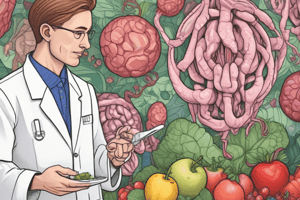Podcast
Questions and Answers
What is cachexia characterized by?
What is cachexia characterized by?
- Loss of muscle and bone density
- Loss of bone density and fat mass
- Loss of muscle with or without loss of fat mass (correct)
- Loss of fat mass without muscle loss
Which medical condition is NOT associated with cachexia?
Which medical condition is NOT associated with cachexia?
- Chronic obstructive pulmonary disease
- Cancer
- Osteoporosis (correct)
- Chronic heart failure
What is the most obvious symptom of cancer cachexia?
What is the most obvious symptom of cancer cachexia?
- Wasting of adipose tissue
- Loss of skeletal muscle mass (correct)
- Loss of cardiac muscle mass
- Depletion of muscle in other visceral organs
What impact does cachexia have on patient quality of life?
What impact does cachexia have on patient quality of life?
Which biological systems experience a disturbed balance in cachexia?
Which biological systems experience a disturbed balance in cachexia?
What is cancer cachexia associated with in terms of responses to chemotherapy and survival?
What is cancer cachexia associated with in terms of responses to chemotherapy and survival?
Which factor is speculated to be more important and relevant to cachexia than the systemic circulation of circulating cytokines?
Which factor is speculated to be more important and relevant to cachexia than the systemic circulation of circulating cytokines?
What is the common feature of muscle wasting in relation to STAT3 activation?
What is the common feature of muscle wasting in relation to STAT3 activation?
What has been hypothesized as the source of the APR protein seen in many malignancies and in cachexia?
What has been hypothesized as the source of the APR protein seen in many malignancies and in cachexia?
What is the role of STAT3 in cytokine-induced pathways?
What is the role of STAT3 in cytokine-induced pathways?
What is the speculation regarding the importance of local production in affected tissues?
What is the speculation regarding the importance of local production in affected tissues?
What is the common feature of STAT3 activation in muscle wasting?
What is the common feature of STAT3 activation in muscle wasting?
What is the speculated relevance of local production in affected tissues to cachexia?
What is the speculated relevance of local production in affected tissues to cachexia?
What is the common feature of STAT3 activation in muscle wasting?
What is the common feature of STAT3 activation in muscle wasting?
What is the approximate prevalence of cachexia in the last 1-2 weeks of life for cancer patients?
What is the approximate prevalence of cachexia in the last 1-2 weeks of life for cancer patients?
Which cytokine is observed to be higher in patients with cachexia than weight-stable patients?
Which cytokine is observed to be higher in patients with cachexia than weight-stable patients?
What is the approximate percentage of weight loss that usually leads to death in cancer patients?
What is the approximate percentage of weight loss that usually leads to death in cancer patients?
Which proteins indicate systemic inflammation in cancer cachexia?
Which proteins indicate systemic inflammation in cancer cachexia?
Which factor increases gluconeogenesis, lipolysis, and proteolysis in cachectic skeletal muscle?
Which factor increases gluconeogenesis, lipolysis, and proteolysis in cachectic skeletal muscle?
What is the primary recommended management strategy for cancer cachexia?
What is the primary recommended management strategy for cancer cachexia?
Flashcards are hidden until you start studying
Study Notes
Cancer Cachexia: Mechanisms and Treatment Options
- Cachexia occurs in the majority of terminal cancer patients and is responsible for the death of 22% of cancer patients.
- Approximately half of all cancer patients experience cachexia, with the prevalence rising as high as 86% in the last 1-2 weeks of life.
- Death usually occurs when there is a 30% weight loss, and 45% of patients lose more than 10% of their original body weight over the course of their disease progression.
- The best management strategy of cancer cachexia is to treat the underlying cancer, but this remains an infrequent achievement with advanced cancers.
- Proposed mechanisms of cancer cachexia include an integrated physiological response of substrate mobilization driven by inflammation, including an increase in pro-inflammatory cytokine activity during cancer progression.
- Systemic inflammation is a hallmark of cancer cachexia, indicated by the production of acute-phase response (APR) proteins such as C-reactive protein (CRP) and fibrinogen.
- There is considerable evidence that signaling through cytokines and myostatin/activin pathways has a role in cancer cachexia and anorexia.
- Numerous cytokines, including tumor necrosis factor-alpha (TNF-α), interleukin-1 (IL-1), IL-6, and interferon-gamma (IFN-γ), have been postulated to play a role in the etiology of cancer cachexia.
- TNF-α increases gluconeogenesis, lipolysis, and proteolysis, decreases the synthesis of proteins, lipids, and glycogen, and stimulates the expression of Uncoupling proteins (UCP) 2 and UCP3 in cachectic skeletal muscle.
- IL-1 concentrations increase in the cachectic state and cause an increase in plasma concentrations of tryptophan, leading to early satiety and suppressing hunger.
- Levels of IL-6 were observed to be higher in patients with cachexia than weight-stable patients, although it is not considered to be solely responsible, working through indirect action.
- It is likely that a complex interplay of these factors is responsible for cachexia, rather than each working in isolation.
Studying That Suits You
Use AI to generate personalized quizzes and flashcards to suit your learning preferences.




